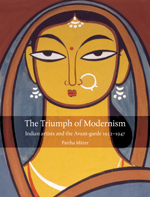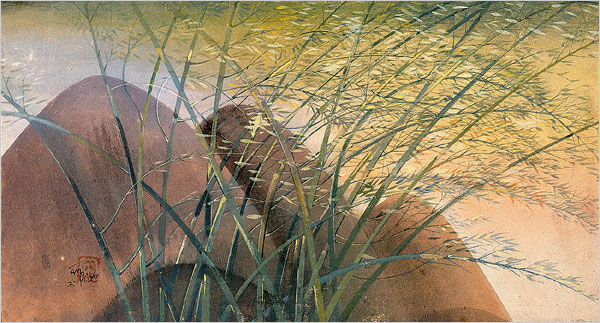
Primitivism in modern Indian art drew on adibasis. […] At Santiniketan, art was to be an integral part of an all-rounded education; Tagore had long considered Abanindranath’s pupil Nandalal [Bose] the best person to give this shape.
The triumph of modernism: India’s artists and the avant-garde, 1922-1947 by Partha Mitter (New Delhi, Oxford Unitversity Press, 2007), p. 79
“Rural communities certainly need education, but their life is interwoven with many social and cultural issues that must all be taken into account. UNESCO is right to argue that an integrated approach with a holistic view is appropriate.” – Dr. Boro Baski >>
[W.G.] Archer’s primitivist longing found the ‘power’, absent in Gaganendranath’s painting, in abundance in India’s tribal sculptures. In The Vertical Man, he expressed admiration for the ‘masculine’ vigour and abstract geometry of Indian tribal art, as he did for the ‘peasant art’ of medieval Britain. Primitivism had bestowed on modernist art criticism the notion of virility as standing for bold simplicity, as opposed to the weakness of complicated ‘feminine’ anecdotal painting. – The Triumph of Modernism, p. 26
It was primitivism that would dominate the decades of the 1920s and ’30s. – The Triumph of Modernism, p. 27
Bengali literature celebrated the natural, healthy Santal way of living, the black lissome [graceful] Santal women providing a counterpoint to the pale cloistered ladies of urban Calcutta. – The Triumph of Modernism, p. 29, Chapter TWO: The Indian discourse of Primitivism
Source: Partha Mitter. The Triumph of Modernism: India’s Artists and the Avant-garde, 1922–1947. ISBN 9780195693362. Hardback edition: November 2007
‘With this book Partha Mitter adds further to his already monumental contribution to the study of Indian art. […] By undertaking to describe and analyze its complexities, this book earns its place in the corpus of distinguished critical literature that warns us against an overtly Eurocentric view of modernity, an alarm already sounded in the author’s celebrated work, Much Maligned Monsters (1977). Furthermore, it alerts all concerned to the indifference that allows South Asian historiography to remain blissfully unaware of what it can and must learn from contemporary writings on the history of art. There is a great deal here for all narratives of colonialism and modernism to feed on.’ —RANAJIT GUHA, founder of Subaltern Studies
Source: OUP : General and Reference – The Triumph of Modernism
Address : http://oup.in/search_detail.php?id=144383
Date Visited: Tue Oct 18 2011 19:00:56 GMT+0200 (CEST)
“If Tagore had done nothing else, what he did at Santiniketan and Sriniketan would be sufficient to rank him as one of India’s greatest nation-builders.” – Krishna Kripalani in Rabindranath Tagore: A Biography >>
Find scholarly books, poetry and fiction relating to tribal culture – Indian publishers
List of sites covered by this Google custom search engine
To find children’s and educational books or search Indian periodicals, magazines, web portals and other sources safely, click here >>
Search tips
Combine the name of any particular state, language or region with that of any tribal (Adivasi) community.
Add keywords of special interest (health, nutrition endangered language, illegal mining, sacred grove); learn about the rights of Scheduled Tribes such as the “Forest Rights Act” (FRA); and the United Nations “Declaration on the Rights of Indigenous Peoples”, “Universal Declaration of Human Rights”, “women’s rights”, or “children’s right to education”.
Specify any other issue or news item you want to learn more about (biodiversity, bonded labour and human trafficking, climate change, ecology, economic development, ethnobotany, ethnomedicine, global warming, Himalayan tribe, hunter-gatherers in a particular region or state, prevention of rural poverty, water access).
For official figures include “scheduled tribe ST” along with a union state or region: e.g. “Chhattisgarh ST community”, “Scheduled tribe Tamil Nadu census”, “ST Kerala census”, “Particularly Vulnerable Tribal Group Jharkhand”, “PVTG Rajasthan”, “Adivasi ST Kerala”, “Adibasi ST West Bengal” etc.
In case the Google Custom Search window is not displayed here try the following: (1) toggle between “Reader” and regular viewing; (2) in your browser’s Security settings select “Enable JavaScript” | More tips >>

See also
eBook | Free catalogue: Museum of Santal Culture (Bishnubati)
eBook | Free catalogue: Banam: One of the ancient musical instruments of the Santals
Santal | Santali language | Santali script – Ol Chiki
The Santhal family and the invention of a subaltern counterpublic
Tips for using interactive maps
Toggle to normal view (from reader view) should the interactive map not be displayed by your tablet, smartphone or pc browser
For details and hyperlinks click on the rectangular button (left on the map’s header)
Scroll and click on one of the markers for information of special interest
Explore India’s tribal cultural heritage with the help of another interactive map >>